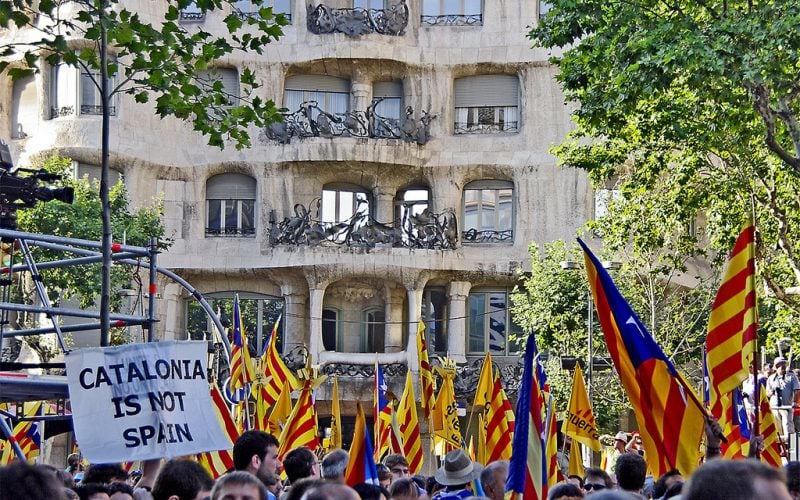 Spain is on the verge of imposing direct rule over Catalonia, with potentially explosive consequences. GRI’s Marc Hernando Santacana asks: How did we get here?
Spain is on the verge of imposing direct rule over Catalonia, with potentially explosive consequences. GRI’s Marc Hernando Santacana asks: How did we get here?
The dramatic developments since the independence referendum may feel sudden, but nationalism in the Catalan region of Spain is nothing new. There was the Modernist political movement of the early 20th century – and the 1976 demonstrations demanding political amnesty, greater freedoms, and a new Statute of Autonomy. In more recent years, a clear sequence of events has resulted in an ever-greater part of the population embracing the idea that Catalonia might be better off on its own.
In 2010, based on an appeal by the conservative Partido Popular, Spain’s Constitutional Court cut back a significant proportion of a revised Statute of Autonomy for Catalonia that had already been approved by referendum, and that then-President Rodríguez Zapatero had promised he would support. The Catalan responded with a one million-strong demonstration that cut across the political spectrum. Then the Catalan started to make demands for a more favourable taxation system, arguing that Catalonia was losing economic potential under the existing arrangements. The simmering discontent culminated on Catalonia’s National Day, 11 September, when 1.5 million people took the streets. They were asking for the “right to choose”: a referendum that would gauge public opinion on independence. This demonstration even saw the participation of Spanish national parties such as the Socialist Party, since it was not officially a pro-independence rally.
Every 11 September since then has seen civil society groups organize public demonstrations that shifted towards expressing outright demands for independence. In 2014, a first attempt to hold a referendum took place. The Constitutional Court ruled the referendum illegal even before it took place, but the result – 80% in favour of independence – nonetheless had a political impact.
Soon afterwards, regional elections were held and the parties supporting independence gained a majority of seats in the Catalan Parliament.
The new cabinet took further steps towards a hypothetical independence process that was supposed to last two to three years. Meanwhile, tensions hardened between separatists and unionists. And there were other driving forces at play as well. These included “the economic crisis, the loss of legitimacy of Spanish political institutions and elites, the attractions of identity politics, and comparative grievances”, as LSE Spanish Studies Professor Sebastian Balfour told GRI at the time.
The perception grew that Madrid did not have Catalonia’s best interests at heart. Earlier this year, a plot under the name of “Operation Catalonia” was uncovered, causing widespread indignation in the region. According to judicial records, Spain’s former Minister of the Interior Jorge Fernández Díaz had conspired with high ranking police officials to delegitimize some Catalan political figures and, consequently, the process of independence.
In June 2017, the date of the current referendum was set for October. Spanish authorities indicated they were prepared use any means necessary in order to prevent it from happening. On 1 October, this was taken a step further when Guardia Civil troops actually used forced to stop people from voting.
Two distinct political groupings have formed over the years in relation to the independence issue. There is the nationalist movement, backed by political parties such as Junts pel Sí and the Candidatura d’Unió Popular and civil society organizations such as the National Assembly of Catalonia and Òmnium Cultural. This is opposed by the unionist movement, which includes the Partido Popular and Ciudadanos; the sole civic group supporting it is called Catalan Civil Society. In terms of the population, the demographics joining both causes are fairly homogeneous in terms of geographical origin and social status.
The two largest outliers within the Catalan borders are Podemos and the Socialist Party of Catalonia. They have been quoted both in favor and against the separatist movement. The real wildcard, however, might be the European Union. As a supranational organization, it might have the most leverage in terms of an agreement being reached, but thus far has largely stayed out of the fray.
In the initial aftermath of the referendum, there was some expectation in Catalonia that President Charles Puigdemont would unilaterally declare independence within the week. Instead, he equivocated: seeming to make the declaration, then suspending it and calling for talks with Spain. However, the Spanish side refuses to negotiate unless the referendum result is annulled. This has led to a new escalation, where Spain intends to invoke Article 155 of the Constitution, imposing direct rule on Catalonia – unless the region agrees to hold snap elections.
This way out has also been rejected by Puigdemont, who instead has gone out to join mass demonstrations, calling Madrid’s threats of direct rule “an attack” and an attempt to destroy democracy. He has nonetheless reiterated that his offers of dialogue are “genuine”.
Neither party seems willing to make compromises. Under these conditions, more forceful actions by Madrid are likely, which will further alienate the Catalan population, making a compromise even more difficult. An intervention by a greater authority – the EU – seems increasingly necessary.
This article was originally published on Global Risk Insights, and was written by Marc Hernando Santacana.